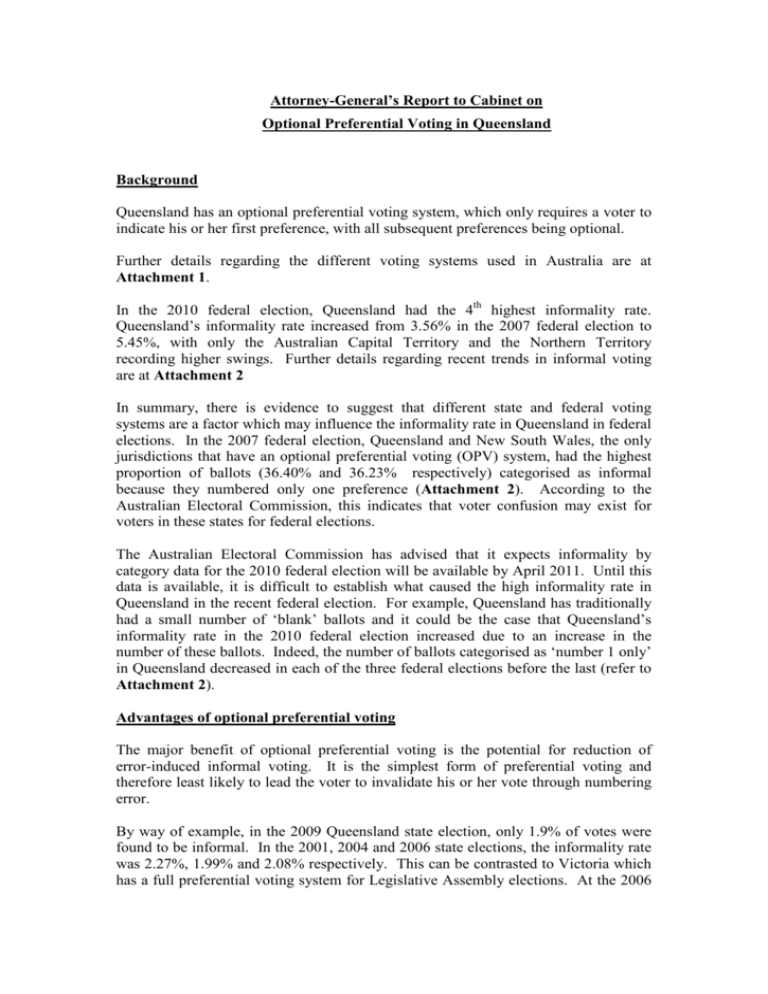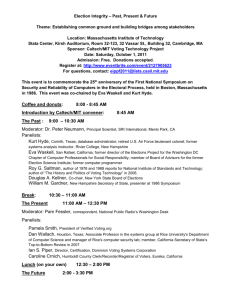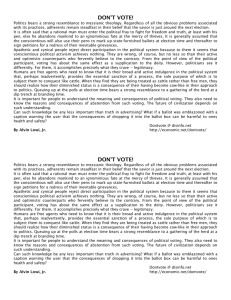Optional Preferential Voting in Queensland
advertisement

Attorney-General’s Report to Cabinet on Optional Preferential Voting in Queensland Background Queensland has an optional preferential voting system, which only requires a voter to indicate his or her first preference, with all subsequent preferences being optional. Further details regarding the different voting systems used in Australia are at Attachment 1. In the 2010 federal election, Queensland had the 4th highest informality rate. Queensland’s informality rate increased from 3.56% in the 2007 federal election to 5.45%, with only the Australian Capital Territory and the Northern Territory recording higher swings. Further details regarding recent trends in informal voting are at Attachment 2 In summary, there is evidence to suggest that different state and federal voting systems are a factor which may influence the informality rate in Queensland in federal elections. In the 2007 federal election, Queensland and New South Wales, the only jurisdictions that have an optional preferential voting (OPV) system, had the highest proportion of ballots (36.40% and 36.23% respectively) categorised as informal because they numbered only one preference (Attachment 2). According to the Australian Electoral Commission, this indicates that voter confusion may exist for voters in these states for federal elections. The Australian Electoral Commission has advised that it expects informality by category data for the 2010 federal election will be available by April 2011. Until this data is available, it is difficult to establish what caused the high informality rate in Queensland in the recent federal election. For example, Queensland has traditionally had a small number of ‘blank’ ballots and it could be the case that Queensland’s informality rate in the 2010 federal election increased due to an increase in the number of these ballots. Indeed, the number of ballots categorised as ‘number 1 only’ in Queensland decreased in each of the three federal elections before the last (refer to Attachment 2). Advantages of optional preferential voting The major benefit of optional preferential voting is the potential for reduction of error-induced informal voting. It is the simplest form of preferential voting and therefore least likely to lead the voter to invalidate his or her vote through numbering error. By way of example, in the 2009 Queensland state election, only 1.9% of votes were found to be informal. In the 2001, 2004 and 2006 state elections, the informality rate was 2.27%, 1.99% and 2.08% respectively. This can be contrasted to Victoria which has a full preferential voting system for Legislative Assembly elections. At the 2006 Victorian state election, the informal voting rate for the Legislative Assembly was 4.56 percent, up from 3.42% percent at the 2002 Victorian state election. Other advantages of OPV include: · The simplification in preferential voting increases participation in the electoral system by allowing people to express their true intentions; · OPV captures only those preferences that people actually hold, rather than requiring them to express preferences for candidates about which they know nothing. In this regard, OPV may empower the voter; · While OPV can result in a candidate without majority support being elected, the same is possible under a full preferential system. This is because the party that is ranked third in an electorate is in a position to arrange a preference deal resulting in the candidate with the lower primary vote being elected; and · Other practical benefits of the adoption of OPV include removal of the need to decide preference distribution, a lesser need for electoral staff to educate voters on how to vote, easier scrutineering and counting of votes and it saves voter time. Disadvantages of optional preferential voting A key issue with OPV is that it has the potential to become a de facto ‘first past the post’ system. This is because preferences can be quickly exhausted where a large number of voters choose to vote ‘1’ only. This is particularly problematic where a large number of candidates are contesting a seat. In such a circumstance, it would be possible for a candidate to be elected with only a small proportion of the vote, which could leave the majority of the population unrepresented. As part of its analysis of a survey of ballot papers from the 2009 state election, the Queensland Electoral Commission found that approximately 63.03% of ballot papers were marked ‘1 only’. At the 2006 election, 62.15% of surveyed ballot papers fell into this category. Up until the 2001 election, the number of ballot papers marked ‘1 only’ had been significantly lower (20.7% in the 1995 election). Other disadvantages of OPV include: · Full preferential voting elects candidates most preferred by voters, due to the allocation of preferences; · It is reasonable to expect voters to express a full ordering of preferences, even when they have a philosophical or intellectual inability to differentiate between candidates; · Full preferential voting allows parties which are allied, or in coalition, to run against each other without necessarily affecting the electoral prospects of either party; · Full preferential voting allows minor parties to have an influence on the election process through the allocation of preferences; and · OPV could undermine democracy if voters simply follow party instructions to vote for one candidate and do not allocate preferences out of ignorance or unfamiliarity. Previous consideration of optional preferential voting in Queensland At the Queensland level, OPV has not been considered in detail since 1990 when its introduction was recommended by the Electoral and Administrative Review Commission (EARC). EARC was responding to the argument that the law should not force electors to vote for candidates they do not wish to see elected. At the Commonwealth level, OPV has been considered by the Joint Standing Committee on Electoral Matters (JSCEM) following each federal election. In its most recent report (June 2009), the Committee supports the retention of full preferential voting for the House of Representatives. However, given that the recent Agreement between the Australian Greens and the Australian Labor Party (ALP) specifically notes that Senator Bob Brown will reintroduce as a Private Members’ Bill the Commonwealth Electoral (Above-the-Line Voting) Amendment Bill 2008 and that the ALP will consider the Bill and work with the Greens to reach reforms satisfactory to the Parties, the voting system used at the Commonwealth level (at least insofar as the Senate is concerned) is likely to be reconsidered in the near future. In September 2009, the Australian Government released the Electoral Reform Green Paper – Strengthening Australia’s Democracy. This paper, which canvasses a wide range of issues related to electoral reform, specifically sought comment in relation to whether: · optional preferential voting should be introduced for the House of Representatives; · preferential above-the-line voting or optional preferential voting below the line should be introduced for the Senate; and · there would be benefits in greater harmonisation of voting systems across Australia. The Australian Government is yet to release a response to this paper. OPV has been considered by the Australian Electoral Commission insofar as it is has been identified as one of the four significant influences that correlate strongly with higher than average informality rates. The Electoral Matters Committee in Victoria also recently considered OPV. As part of its Inquiry into Voter participation and Informal Voting in Victoria in 2009, the Committee received a submission from the Victorian Electoral Commission that the introduction of OPV at Victorian state elections could reduce informal voting. Although the Committee recognised that OPV could lead to reductions in errorrelated informal voting, it did not recommend introduction of OPV in Victorian lower house elections due to concerns that OPV could lead to voter confusion at Victorian federal and local government elections (where full preferential voting only is available to electors) and an increase in informal voting rates. Issues to be considered if full preferential voting is introduced in Queensland A key issue to be considered if full preferential voting is introduced in Queensland is whether a savings provision should be introduced. As part of its Report on the Conduct of the 2007 Federal Election and Matters Related Thereto, the Joint Standing Committee on Electoral Matters (JSCEM) recently recommended the reintroduction of the savings provisions that existed in the Commonwealth Electoral Act between the 1984 and 1996 elections. These provisions allow ballot papers with non consecutive numbering errors to be included in the count up to the point at which the numbering error began. While JSCEM acknowledged concerns that a savings provision may result in ‘the reemergence of campaigns advocating for optional preferential voting’, it considered that ‘these concerns do not justify the exclusion of up to 90,000 votes where electors have expressed clear preferences for a number of candidates but may have made mistakes in numbering their ballot paper’. ATTACHMENT 1 Voting systems Jurisdiction Commonwealth Full preferential House ü Senate ü Optional preferential Partial preferential (or ticket) New South Wales ü Legislative Assembly ü Legislative Council Victoria Legislative Assembly (or optional preferential ticket) ü ü Legislative Council (or ticket) ü Queensland Legislative Assembly Western Australia Legislative Assembly ü Legislative Council ü South Australia (or ticket) Legislative Assembly ü Legislative Council ü (or ticket) Legislative Assembly ü Legislative Council ü Australian Capital Territory Legislative Assembly ü Northern Territory Legislative Assembly Tasmania ü · Under partially optional preferential voting, a number of preferences greater than one but less than the number of candidates must be shown for a vote to be formal. · The New South Wales lower house and Queensland have optional preferential voting, which only requires a voter to indicate his or her first preference, with all subsequent preferences being optional. · In addition to different preferential systems, different jurisdictions have different formality rules (for example a tick or a cross is not acceptable in some jurisdictions, while other jurisdictions have provisions that ‘save’ votes not marked in accordance with ballot paper instructions). ATTACHMENT 2 Informal voting trends · The AEC has released statistics showing the number of informal votes by State for the House of Representatives at the 2010 federal election: State Formal Votes Informal Total Votes Votes Informal Percentage Informal Swing New South Wales 4009318 293763 4303081 6.83 1.88 Victoria 3180184 149699 3329883 4.5 1.25 Queensland 2384179 137395 2521574 5.45 1.89 Western Australia 1204001 60967 1264968 4.82 0.97 South Australia 979949 56565 1036514 5.46 1.68 Tasmania 327152 13791 340943 4.04 1.12 Australian Capital Territory 223697 10926 234623 4.66 2.35 Northern Territory 93883 6198 100081 6.19 2.34 http://results.aec.gov.au/15508/Website/HouseInformalByState-15508.htm. · In the 2010 election, the percentage of informal votes increased and Queensland had the 4th highest (5.45%) level of informality. · Following the 2001, 2004 and 2007 federal elections, the AEC conducted an analysis of informal votes for the House of Representatives. The Australian Electoral Commission has advised that it expects informality by category data for the 2010 federal election will be available by April 2011. · The 2007 analysis identified four significant influences that correlate strongly with higher than average informality rates. These are: - divisions with high candidate counts; - differences in state and federal electoral systems; - proximity to other election events; and - a high proportion of citizens from non-English speaking backgrounds. · In the 2004 and 2007 federal elections, NSW and QLD (both of which have optional preferential voting systems) recorded the highest proportion of informal votes in federal elections due to electors casting number ‘1 only’ and ‘incomplete’ ballots: Informality by category, 2001, 2004 and 2007 Federal Elections Category ACT NSW NT QLD SA 2001 30.84 20.38 20.74 15.67 24.52 2004 23.58 21.18 18.77 15.24 2007 25.81 18.21 14.99 2001 28.76 32.47 2004 35.57 2007 TAS VIC WA 27.86 24.95 23.36 23.16 28.21 24.16 22.89 15.37 26.87 29.34 23.33 23.55 27.95 46.42 36.63 23.60 26.05 29.87 35.65 27.65 44.57 30.91 22.37 21.81 25.25 25.88 36.23 24.70 36.40 24.30 17.33 21.61 18.01 2001 - - - - - - - - 2004 3.05 5.23 3.71 4.63 3.05 2.75 3.05 4.97 2007 3.10 5.29 3.63 5.27 3.29 4.47 2.94 4.57 2001 8.99 12.57 10.62 11.46 14.95 15.84 12.97 9.93 2004 8.00 10.71 9.00 7.37 11.72 11.42 7.40 9.18 2007 10.19 11.00 15.22 9.35 12.79 7.17 8.08 8.29 2001 7.66 22.52 15.06 10.49 13.40 13.17 14.15 21.75 2004 4.88 15.22 19.85 9.79 14.12 8.19 20.39 19.31 2007 9.91 15.78 24.39 15.15 15.92 15.04 21.42 26.33 2001 0.04 0.04 - 0.03 0.03 0.02 0.07 0.11 2004 - 0.04 0.05 0.06 0.05 0.07 0.06 0.02 2007 0.11 0.07 0.20 0.04 0.03 0.02 0.13 0.07 2001 4.20 5.49 2.98 4.91 5.97 12.11 8.23 7.78 2004 20.21 9.62 15.60 15.65 13.72 24.66 20.14 15.94 2007 22.44 11.51 13.29 16.22 14.87 25.07 20.30 16.87 2001 18.68 4.15 8.09 9.02 3.44 0.52 4.40 3.01 2004 3.90 2.28 5.36 2.70 3.06 2.33 2.99 2.43 2007 2.55 1.91 3.58 2.19 1.94 1.56 2.90 2.30 Blank Number 1 only Incomplete numbering Ticks and crosses Non-sequential Voter identified Marks and scribbles Other http://www.aec.gov.au/About_AEC/Publications/Strategy_Research_Analysis/paper_11/research_paper11.pdf). · However, in the 2007 federal election, the AEC noted that while NSW had the highest level of informality (4.95%), Queensland had only the 5th highest (3.56%). Although the AEC noted that this could have been a consequence of the proximity of the state event to the federal election (the NSW election was held much closer than the QLD election), the AEC was of the view that the statistics may suggest that other factors are more significant predictors of informality than different state and federal systems of voting. State 2001 Federal Election 2004 Federal Election 2007 Federal Election 2010 Federal Election Informal Percentage Informal Percentage Informal Percentage Informal Percentage New South Wales 5.42 6.12 4.95 6.83 Victoria 3.98 4.10 3.25 4.5 Queensland 4.83 5.16 3.56 5.45 Western Australia 4.92 5.32 3.85 4.82 South Australia 5.54 5.56 3.78 5.46 Tasmania 3.40 3.59 2.92 4.04 Australian Capital Territory 3.52 3.44 2.31 Northern Territory 4.64 4.45 3.85 6.19 National 4.82 5.18 3.95 5.55 4.66 Analysis of Informal Voting - House of Representatives 2007 Election, AEC, Research Report Number 11, June 2009 (http://www.aec.gov.au/About_AEC/Publications/Strategy_Research_Analysis/paper_11/research_pap er11.pdf). House of Representatives 2010 Election, Informal votes by state, AEC http://results.aec.gov.au/15508/Website/HouseInformalByState-15508.htm. · In a recent submission to the Electoral Reform Green Paper – Strengthening Australia’s Democracy, the Australian Electoral Commission stated that: ….strict formality rules which apply to House of Representatives elections and require the elector to indicate a consecutive preference for every candidate, further disadvantage particular sectors of the community. AEC studies have demonstrated the highest levels of informality occur in electorates with the highest proportion of citizens from non-English speaking backgrounds. High levels of informality means that significant numbers of Australians who are in fact motivated to participate are prevented by the operation of current rules from casting an effective ballot. If not addressed, the combination of low participation and high informality has the potential to diminish public confidence in the ongoing validity and credibility of election results.






